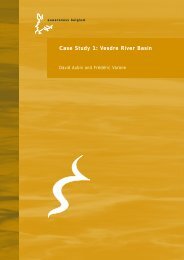Case Study 1: Matarraña River Basin - Euwareness
Case Study 1: Matarraña River Basin - Euwareness
Case Study 1: Matarraña River Basin - Euwareness
Create successful ePaper yourself
Turn your PDF publications into a flip-book with our unique Google optimized e-Paper software.
Regarding the regulative system, both water and sectoral legislation introduce marginal<br />
changes in the de facto use rights and protection system at the <strong>Matarraña</strong> river basin.<br />
The 29/1985 Water Act introduces the concept of hydraulic public domain for surface<br />
and ground waters, which means that private ownership is almost suppressed (there<br />
are still temporary basis which recognise water private property according to the<br />
previous legislation). The Act regulates privative uses of water and requests an<br />
authorisation or a concession to allow them. It also regulates the need to register water<br />
concessions in the Water register. In practice, at the <strong>Matarraña</strong> river basin level this<br />
regulative framework has been marginally implemented: most concessions are not<br />
registered in the Water Register, about 30% of the extension of the river basin uses<br />
water illegally, and tradition allows for the existence of de facto use rights beyond the<br />
regulative system. Maybe the creation of Users Communities in locations where users<br />
were not organised has been one of the most noticeable impacts of the 1985 Water<br />
Act. Apart from that, the 29/1985 Water Act also establishes the elaboration of river<br />
basin plans. In the case of the Ebro river, the CHE elaborated its river basin plan in<br />
1998, establishing water needs and uses as well as the ecological flow. This flow may<br />
or may not be respected, and water sometimes is consumed for uses other than those<br />
established by the plan. Apart from that, sectoral legislation, mainly the one regulating<br />
environmental protection (mostly with an EU origin) has generated certain constraints<br />
and opportunities in the regulation system. For instance, legislation on habitats or fish<br />
species. However, this legislation may be easily bypassed.<br />
The most salient changes of the regime concern the policy system. As it was pointed<br />
out previously, changes can be detected as regards the multilevel dimension of<br />
governance, the problem perception and the actors in the policy network. To sum up,<br />
conflict traditionally has confronted actors located at the higher, middle and lower river<br />
basin and has been more intense in periods of water scarcity. The increasing multilevel<br />
nature of governance means that legislation, arenas, actors and resources at different<br />
scales of governance play a role in the governance system. In the late nineties,<br />
territorial rivalries intensify both because of the ability of ‘conservationist’ actors of<br />
mobilising resources and actors located at different levels of governance and because<br />
of the increasing perception of risk caused by an extreme situation of drought. Conflict<br />
is relaxed and a new perception viewing water in the <strong>Matarraña</strong> river basin as a<br />
resource to be preserved becomes dominant.<br />
In order to explain regime change, two sets of variables can be identified: those<br />
62



